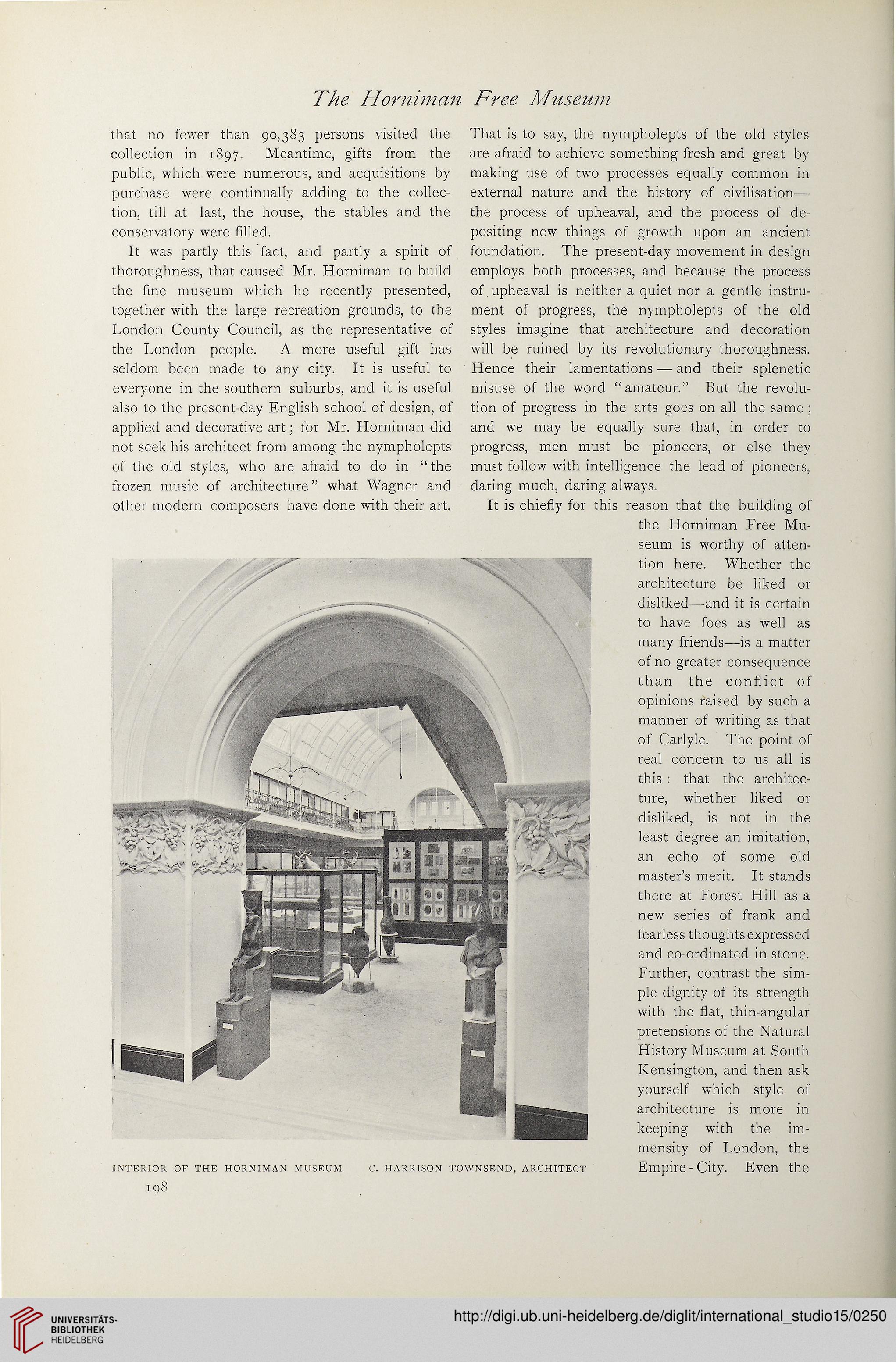The Horniman Free Museum
that no fewer than 90,383 persons visited the
collection in 1897. Meantime, gifts from the
public, which were numerous, and acquisitions by
purchase were continually adding to the collec-
tion, till at last, the house, the stables and the
conservatory were filled.
It was partly this fact, and partly a spirit of
thoroughness, that caused Mr. Horniman to build
the fine museum which he recently presented,
together with the large recreation grounds, to the
London County Council, as the representative of
the London people. A more useful gift has
seldom been made to any city. It is useful to
everyone in the southern suburbs, and it is useful
also to the present-day English school of design, of
applied and decorative art; for Mr. Horniman did
not seek his architect from among the nympholepts
of the old styles, who are afraid to do in “the
frozen music of architecture ” what Wagner and
other modern composers have done with their art.
That is to say, the nympholepts of the old styles
are afraid to achieve something fresh and great by
making use of two processes equally common in
external nature and the history of civilisation—
the process of upheaval, and the process of de-
positing new things of growth upon an ancient
foundation. The present-day movement in design
employs both processes, and because the process
of upheaval is neither a quiet nor a gentle instru-
ment of progress, the nympholepts of the old
styles imagine that architecture and decoration
will be ruined by its revolutionary thoroughness.
Hence their lamentations — and their splenetic
misuse of the word “amateur.” But the revolu-
tion of progress in the arts goes on all the same ;
and we may be equally sure that, in order to
progress, men must be pioneers, or else they
must follow with intelligence the lead of pioneers,
daring much, daring always.
It is chiefly for this reason that the building of
the Horniman Free Mu-
seum is worthy of atten-
tion here. Whether the
architecture be liked or
disliked—and it is certain
to have foes as well as
many friends—is a matter
of no greater consequence
than the conflict of
opinions raised by such a
manner of writing as that
of Carlyle. The point of
real concern to us all is
this : that the architec-
ture, whether liked or
disliked, is not in the
least degree an imitation,
an echo of some old
master’s merit. It stands
there at Forest Hill as a
new series of frank and
fearless thoughts expressed
and co-ordinated in stone.
Further, contrast the sim-
ple dignity of its strength
with the flat, thin-angular
pretensions of the Natural
History Museum at South
Kensington, and then ask
yourself which style of
architecture is more in
keeping with the im-
mensity of London, the
Empire-City. Even the
that no fewer than 90,383 persons visited the
collection in 1897. Meantime, gifts from the
public, which were numerous, and acquisitions by
purchase were continually adding to the collec-
tion, till at last, the house, the stables and the
conservatory were filled.
It was partly this fact, and partly a spirit of
thoroughness, that caused Mr. Horniman to build
the fine museum which he recently presented,
together with the large recreation grounds, to the
London County Council, as the representative of
the London people. A more useful gift has
seldom been made to any city. It is useful to
everyone in the southern suburbs, and it is useful
also to the present-day English school of design, of
applied and decorative art; for Mr. Horniman did
not seek his architect from among the nympholepts
of the old styles, who are afraid to do in “the
frozen music of architecture ” what Wagner and
other modern composers have done with their art.
That is to say, the nympholepts of the old styles
are afraid to achieve something fresh and great by
making use of two processes equally common in
external nature and the history of civilisation—
the process of upheaval, and the process of de-
positing new things of growth upon an ancient
foundation. The present-day movement in design
employs both processes, and because the process
of upheaval is neither a quiet nor a gentle instru-
ment of progress, the nympholepts of the old
styles imagine that architecture and decoration
will be ruined by its revolutionary thoroughness.
Hence their lamentations — and their splenetic
misuse of the word “amateur.” But the revolu-
tion of progress in the arts goes on all the same ;
and we may be equally sure that, in order to
progress, men must be pioneers, or else they
must follow with intelligence the lead of pioneers,
daring much, daring always.
It is chiefly for this reason that the building of
the Horniman Free Mu-
seum is worthy of atten-
tion here. Whether the
architecture be liked or
disliked—and it is certain
to have foes as well as
many friends—is a matter
of no greater consequence
than the conflict of
opinions raised by such a
manner of writing as that
of Carlyle. The point of
real concern to us all is
this : that the architec-
ture, whether liked or
disliked, is not in the
least degree an imitation,
an echo of some old
master’s merit. It stands
there at Forest Hill as a
new series of frank and
fearless thoughts expressed
and co-ordinated in stone.
Further, contrast the sim-
ple dignity of its strength
with the flat, thin-angular
pretensions of the Natural
History Museum at South
Kensington, and then ask
yourself which style of
architecture is more in
keeping with the im-
mensity of London, the
Empire-City. Even the





